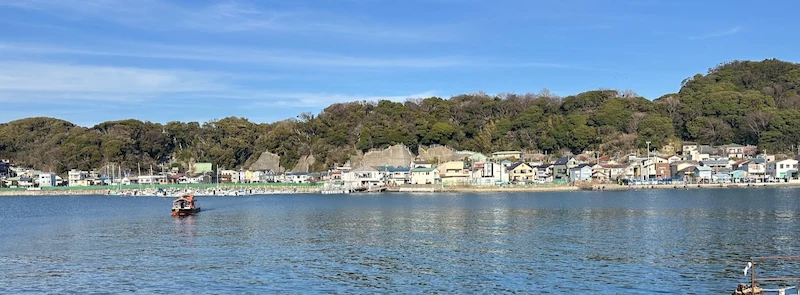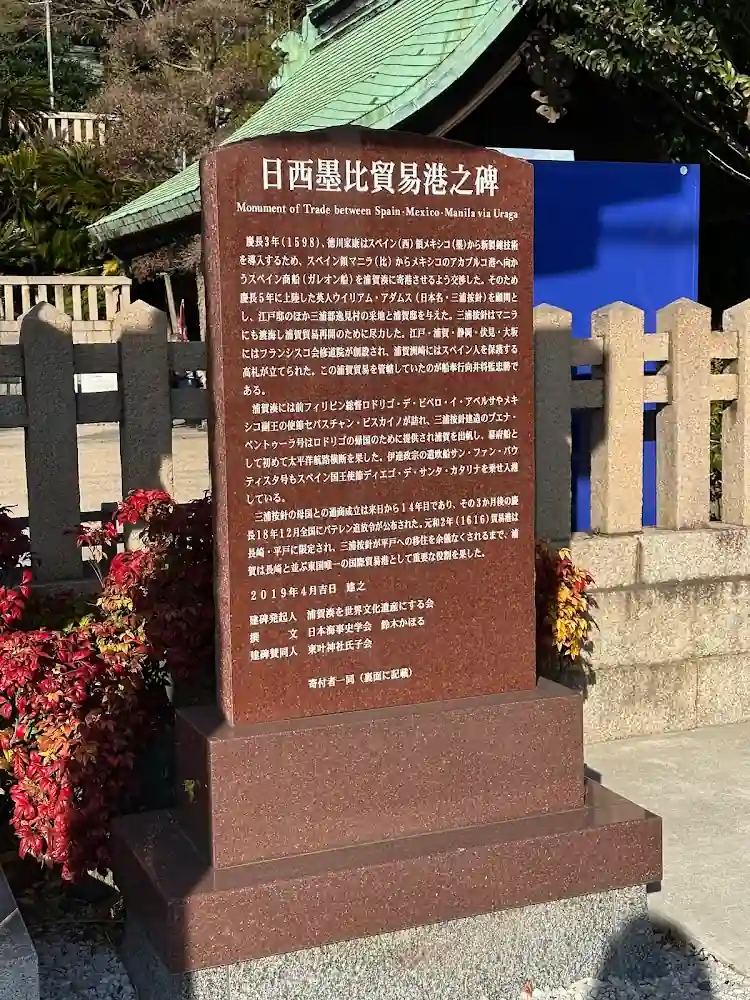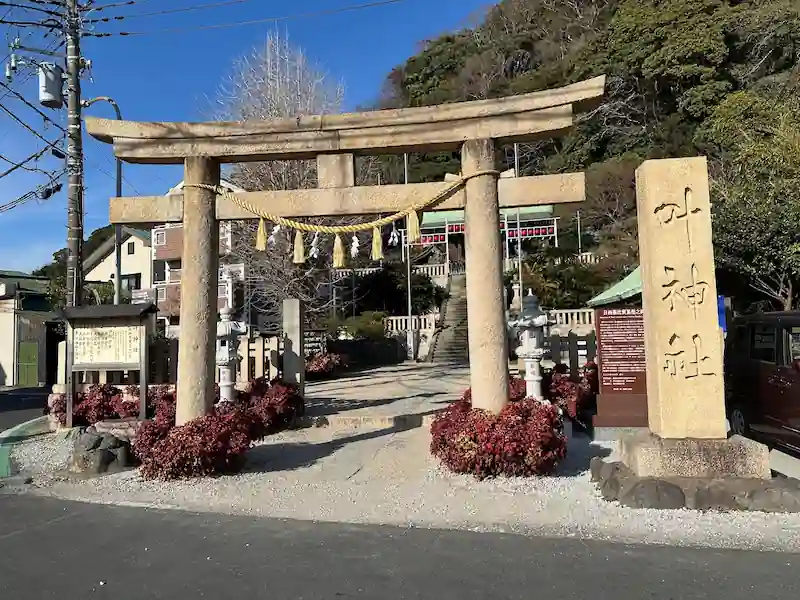
Anjin, the blue-eyed samurai portrayed in the TV drama “SHŌGUN,” was inspired by the real-life figure William Adams—known in Japan as Miura Anjin. One of the key places with which he was deeply involved was the port town of Uraga in Yokosuka City, Kanagawa Prefecture. Today, Uraga is widely known as the location where Commodore Perry’s Black Ships arrived in the late Edo period. However, few realize that in the early days of the Tokugawa Shogunate, Tokugawa Ieyasu and Anjin envisioned Uraga as a future hub for international trade.
- 🚉 How to Get Here: Uraga station
- Why Uraga? — Ieyasu’s International Strategy and Anjin’s Mission
- Anjin’s Work in Uraga — A Hub for Trade, Shipbuilding, and Diplomacy
- Traces Left Behind — Vanished Residences, Enduring Names, and Monuments
- Travel Guide: Walking in Anjin’s Footsteps Through Uraga
- Monument to Japan-Spain-Mexico-Philippines Trade
- Back to the Miura Anjin Page
🚉 How to Get Here: Uraga station
From Haneda Airport:
Approx. travel time: 89 minutes, Fare: 720JPY.
From Tokyo Station:
Approx. travel time: 85 minutes, Fare: 950 JPY.
Why Uraga? — Ieyasu’s International Strategy and Anjin’s Mission
In 1600, several years after William Adams washed ashore in Bungo Province, he earned the trust of Tokugawa Ieyasu and was invited to Edo as an advisor on diplomacy, navigation, and shipbuilding. Although he was granted a fief in Henmi Village (now Nishihemi-cho, Yokosuka City) on the Miura Peninsula, historical evidence suggests that his primary base of operations was actually further east in Uraga.
Located at the mouth of Edo Bay, Uraga is a natural deep-water harbor with calm waters, making it ideal for shipbuilding and anchorage. Its proximity to Edo also gave it significant strategic importance for both military and economic purposes.
Ieyasu aimed to establish trade routes with the Dutch, Spanish, and Portuguese, and he expected Anjin to play a central role in negotiating and providing technical guidance. Among Anjin’s key responsibilities was the construction and repair of ocean-going vessels based in Uraga, and the development of a Western-style international port.
Anjin’s Work in Uraga — A Hub for Trade, Shipbuilding, and Diplomacy
According to local traditions and historical records, Anjin established his operational and residential base on the eastern shore of Uraga (near present-day Higashi-Uraga-cho). Particularly noteworthy are **Kajiyamachi (around present-day Hōdōji Temple)**—where Anjin is said to have carried out shipbuilding and repair—and the **site traditionally believed to be Anjin’s residence (the area behind the south side of Tōrinji Temple)**.
It is also believed that Anjin oversaw repairs at Uraga Port when the Spanish galleon “San Francisco,” which sailed between Manila and Acapulco, was shipwrecked off the coast of Japan. This incident suggests that Uraga may have briefly served as a key stopover on the trans-Pacific route.
Thanks to Anjin’s diplomatic efforts, Ieyasu pursued trade relations with the Philippines and Mexico. However, after Ieyasu’s death, the shogunate shifted toward national isolation, and this vision of Uraga as a thriving international trade port ultimately went unfulfilled.
Traces Left Behind — Vanished Residences, Enduring Names, and Monuments
No physical structures or confirmed remains of Anjin’s residence exist in Uraga today. However, his legacy endures through place names, oral traditions, and recently erected monuments.
- Traditional Site of Anjin’s Residence (area behind Tōrinji Temple): Now a residential neighborhood, this area was once known as “Anjin Yashiki” (Anjin’s Residence). The name has survived since the Edo period, and some stories suggest the presence of a small shrine Anjin may have revered.
- Kajiyamachi (near Hōdōji Temple): This area was home to blacksmiths who assisted Anjin in repairing shipwrecked vessels, and the name Kajiyamachi (“blacksmith town”) lives on.
- Monument to Japan-Spain-Mexico-Philippines Trade (on the grounds of Higashi-Kano Shrine): Erected in 2019, this stone monument commemorates Anjin’s envisioned international port at Uraga. Engraved with the initials of Japan, Spain, Mexico, and the Philippines, it stands as evidence of Uraga’s brief moment of international openness.
Travel Guide: Walking in Anjin’s Footsteps Through Uraga
Today, Uraga is a peaceful port town, but visitors can still trace Anjin’s legacy by exploring the following sites:
| Spot | Description |
|---|---|
| Higashi-Kano Shrine | Home to the Monument to Japan-Spain-Mexico-Philippines Trade, offering scenic views of Uraga Bay. Known as a shrine where wishes come true. |
| Behind Tōrinji Temple | Traditional site of Anjin’s residence. No markers remain, but the street names and topography offer a glimpse into the past. |
| Around Hōdōji Temple | Area reminiscent of Kajiyamachi, where blacksmiths once gathered. |
| Uraga Ferry | A ferry in operation since the Edo period, possibly used by Anjin himself to travel between West and East Uraga. |
Monument to Japan-Spain-Mexico-Philippines Trade

In Keichō 3 (1598), Tokugawa Ieyasu initiated negotiations to bring a Spanish galleon—en route from Manila (then a Spanish colony) to the port of Acapulco in Mexico (also under Spanish rule)—to call at the port of Uraga. His goal was to introduce advanced refining technology from New Spain (Mexico) into Japan.
To support this effort, Tokugawa appointed the Englishman William Adams (known in Japan as Miura Anjin), who had landed in Japan in Keichō 5 (1600), as his advisor. Adams was granted a residence in Edo, a fief in Henmi Village in Miura District, and a residence in Uraga. He later traveled to Manila and worked tirelessly to reopen trade through Uraga.
Franciscan missions were established in Edo, Uraga, Shizuoka, Fushimi, and Osaka during this period, and a public notice was erected in Uraga’s Suzaki area to protect Spanish nationals.
The official overseeing Uraga’s maritime affairs was Mukai Shōgen Tadakatsu, the shogunate’s naval commissioner.
Uraga Port welcomed several key historical figures, including Rodrigo de Vivero y Aberrucia, former governor-general of the Philippines, and Sebastián Vizcaíno, envoy of the Viceroy of Mexico. The Buena Ventura, a vessel built by Miura Anjin, was offered to Rodrigo for his return voyage and became the first Tokugawa-era ship to successfully cross the Pacific Ocean.
The European envoy ship San Juan Bautista, commissioned by Date Masamune, also called at Uraga with Spanish royal envoy Diego de Santa Catalina aboard.
Formal trade relations with Miura Anjin’s homeland were established 14 years after his arrival in Japan. However, just three months later, in December of Keichō 18 (1613), the nationwide edict to expel Christian missionaries (Bateren) was issued.
By Genna 2 (1616), all international trade was restricted to Nagasaki and Hirado, forcing Miura Anjin to relocate to Hirado. Until that time, Uraga had played a critical role as the only international trading port in eastern Japan, standing alongside Nagasaki in national importance.
Erected: Auspicious day in April 2019
Monument Initiative: Committee for Making Uraga Port a World Heritage Site
Inscription by:
Kahoru Suzuki, Japan Maritime History Society
Monument Funding:
Parishioners of Higashi-Kano Shrine
Donors:
Listed on reverse side of monument

⭐ Recommended Rating
Historical Significance: ★★★
Visual Appeal: ★★
Experiential Value: ★★
The “Monument to Japan-Spain-Mexico-Philippines Trade” is a grand stone marker located within the grounds of Higashi-Kano Shrine in Higashi-Uraga, Yokosuka. Erected in 2019, it commemorates Uraga Port’s brief but remarkable history as an international trading hub during the Keichō era. Miura Anjin (William Adams), trusted by Tokugawa Ieyasu, helped negotiate trade relations with Spain, Mexico (then New Spain), and the Philippines, raising Uraga’s status to the only international port in eastern Japan at the time. Thanks to his efforts, the first trans-Pacific trade route was realized, placing Uraga on par with major ports like Nagasaki and Hirado, as detailed on the monument.
| Year Erected | 2019 (Unveiled on April 25) |
|---|---|
| Commissioned by | Committee for Making Uraga Port a World Heritage Site + Parishioners of Higashi-Kano Shrine |
| Structure & Features | Red granite monument inscribed with a detailed history of Uraga’s role as a trade port with Spain, Mexico, and the Philippines |
| Restoration History | No known restorations since its erection |
| Current Condition | Well-preserved; located along the approach to Higashi-Kano Shrine |
| Cultural Designation | Recognized locally as a historical landmark (not nationally designated) |
| Notes | Inscription includes English translation; the monument and surrounding cherry blossoms are local sightseeing highlights |
🗺 Address: 2-21-25 Higashi-Uraga, Yokosuka, Kanagawa (within Higashi-Kano Shrine)
🚶 Access:
About a 20-minute walk (1.5 km) from Keikyu Uraga Station, or take a Keikyu Bus from the station to “Shinmachi” and walk about 7 minutes.
You can also cross Uraga Bay via the historic ferry (West to East landing), which drops you close to the shrine.
⏳ Suggested Visit Duration
Quick stop: About 10 minutes (for photos and reading the inscription)
In-depth visit: About 30 minutes (including a walk around the Higashi-Kano Shrine grounds)
📍 Highlights
- Trade Monument Inscription: Summarizes Japan’s exchanges during the Keichō era via Spain with Manila and Mexico, the Pacific route, and the transition toward national seclusion, giving insight into the era’s global perspective.
- Monument Placement: Elegantly situated beside the shrine’s approach path, harmonizing with the stone steps, torii gate, and purification fountain.
- Seasonal Appeal: Surrounded by cherry blossoms in spring and vivid foliage in autumn, the monument makes for a picturesque stop—especially when paired with a ferry ride across Uraga Bay.
📌 Trivia
- Monument Name Meaning: “墨” represents Mexico (New Spain), and “比” is shorthand for the Philippines. Together, 日西墨比 stands for the Japan-Spain-Mexico-Philippines trade route.
- Rise and Fall of the Trade Port: In 1616, the Tokugawa shogunate’s isolation policy led to Uraga losing its port status, limiting foreign trade to Nagasaki and Hirado. Anjin was relocated to Hirado as a result.
- Historical Ties with Higashi-Kano Shrine: The group behind the monument, “Committee for Making Uraga Port a World Heritage Site,” chose this location for its deep historical significance. The shrine also features sites like the “Katsu Kaishu Fasting Well,” linking the Edo period to modern history.
For those exploring sites connected to Miura Anjin, this monument is best appreciated alongside nearby landmarks such as Anjin-zuka, Kashima Shrine, and Jōdoji Temple. Together, they offer a richer understanding of Anjin’s contributions to international diplomacy and the historical importance of Edo Bay and Uraga Port.


comment